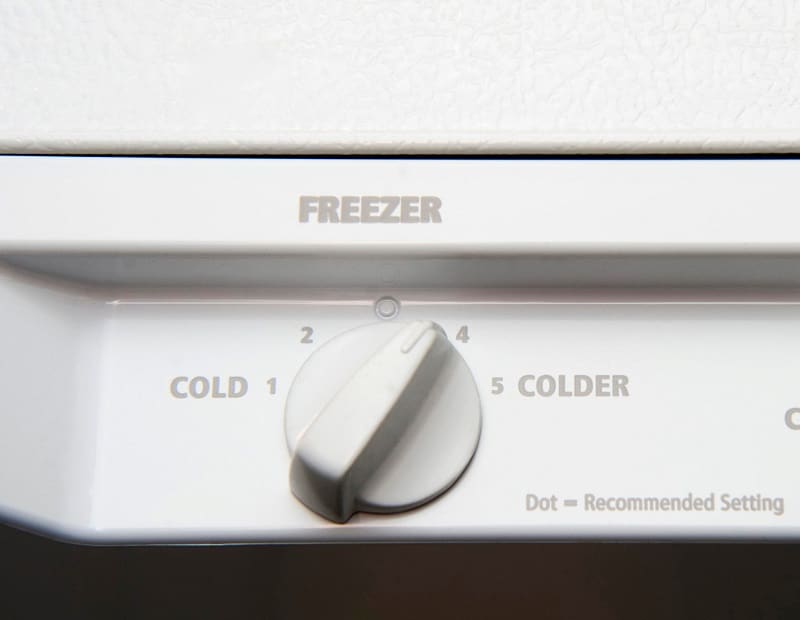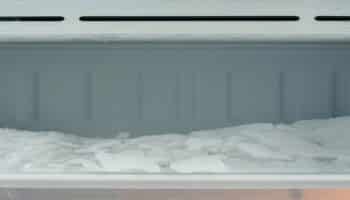We've independently reviewed this article to make sure it's as accurate as we can make it.
To find out more about our article creation and review process, check out our editorial guidelines.
Having trouble getting your freezer to start, even though it keeps clicking?
It’s frustrating when you know your freezer should be turned on, but it just gives you a false noise instead. I dug deep into the answer and have some really helpful tips below.
When your freezer clicks but won’t start, it’s due to a faulty overload capacitor, temperature control, electronic control board, condenser, or compressor. You can fix most of the issues yourself before needing to call a professional.
Ready to get your freezer working again? Let’s dive straight in.
Why trust us? This article was written by Craig Anderson and Andy Fulenchek.
Craig has helped thousands of other homeowners repair their appliances since 2016.
Andy is one of our resident appliance repair experts with over a decade of experience. He currently runs his appliance repair company with a team of trusted technicians.
Why Your Freezer Clicks, But Won’t Start
When your freezer is making a clicking noise, it’s typically because the compressor is turning on or off constantly. The compressor helps cool the refrigerant gas when a cooling cycle turns on, which is what makes your freezer so cold.
When the compressor is having trouble, you’ll hear it clicking often, as it automatically turns itself off and on.
In such cases, the clicking is normal if you only hear it occasionally. Mainly because the cooling cycle can take a while to get the freezer back to the same ideal temperature. When the freezer hits the perfect temperature, the compressor will turn off again, and you’ll hear a clicking noise.
When your compressor is overloaded, though, it will keep turning off and on, trying to reach ideal temperatures.
When you have a faulty piece of equipment in your freezer, the compressor will never be able to reach its perfect temp, and it will get stuck in an endless loop of turning off and on again.
I did some research and found the most common issues of your freezer malfunctioning and what you can do to fix them.
5 Ways to Fix a Clicking Freezer
In my experience, when you keep hearing a freezer clicking noise, you’ll need to check your capacitors, temp controls, electronic control board, condenser, and compressor. Here’s how to do it:
#1 Check the Overload
The overload is connected to your compressor and acts as a mechanical on/off switch when the power comes in through the compressor motor windings.
The overload helps the motor keep running on the compressor, as the compressor can take some time to get up to speed.
The relay capacitor connects the starting capacitor, or run capacitor, to the motor windings and helps to level out the incoming voltage, providing the compressor with a smoother and more consistent power source.
You’ll need a multimeter to check to see if the capacitor and relays can receive electricity or if they’re burned out.
Keep in mind that your multimeter will need a uF (micro-farad) setting to appropriately measure the capacitor.
Provided you don’t have a multimeter handy, you can always try unplugging your freezer from the wall outlet you normally use and connect something else, like a lamp, to see whether there’s something wrong with the power source.
If testing the capacitor, wall outlet, and relays doesn’t solve your problem, try one of the other methods below before calling a service technician.
#2 Look at the Cold Control/Temperature Control
When your freezer is making a clicking noise but won’t turn on, the temperature control is likely malfunctioning. The temperature control does exactly what you think it would – it regulates the temperature in your freezer.
When the temperature reaches the ideal level, the temperature control switches off the fans and compressor.
When the temperature dips below the ideal settings, your temperature control will tell the fans and compressor to turn on. However, if the temperature control is failing, it’s likely that your freezer will only click but not turn on.
You can test your temperature control easily by changing the temperature in your freezer using the control knob.

If you make your freezer colder, but it still doesn’t turn on, you know something is wrong. Your only option is to unplug your freezer from the power source and remove the temperature control box, which houses the temperature control switch.
Remove the terminal leads from your temperature control switch and use a multimeter to check its status.
I recommend accessing the two terminals on the cold control and testing for continuity in the ON position; you should get a low resistance reading, typically between 0.03-0.08 ohms.
If the temperature control isn’t working, you must replace it. You can do the replacement yourself, but if you aren’t feeling up to a challenge, you’ll need to contact a technician.
If you want to get any replacement part – or see how much one would cost – click to enter your model number in the search bar below. Our partners at AppliancePartsPros stock almost every part with free guides on how to install them.

#3 Check the Electronic Control Board
Checking the control board only applies to newer freezers. The electronic board is the main place where all the action is happening in your freezer and fridge – it tells all the other parts to function and controls how your appliance works.
I find that if something’s wrong with your electronic control board, it can cause its relays to click.
Look at your control board, but be cautious not to cause any further damage. You want to look for any burned, deteriorated, or arching wires. You also want to check the part where the power cord enters into the board and ensure the current is 120 volts.
If you notice a problem, it’s best not to fix it yourself. The control board is complicated and often requires someone with much electrical experience to replace it. The typical control board replacement costs anywhere between $250-$400.
Note: Since control boards can be sensitive to power surges, I strongly recommend using appliance-specific surge protectors to prevent damaging yours. General electric surge protectors often won’t work against such surges.
#4 Take a Look at the Condenser Coils
Checking the condenser coils can also help when your freezer is making clicking noises but not starting.
The coils are located in the back of your freezer – they typically don’t get cleaned very often, so they accumulate a ton of dust.
Too much dust and debris on your condenser coils will cause the compressor to overload, which can explain the issue.
My usual advice is to give your condenser coils a good wipe-down before turning on your freezer again. You can buy brushes at some specialty stores that are made specifically to clean condenser coils.
#5 Fix a Faulty Compressor
Go through all the previous steps before considering a compressor issue. The reason is that the compressor is the hardest to fix, and you won’t be able to do it yourself.
Before calling a professional technician, you want to try everything you can to get your freezer working again.
Your compressor usually fails because it’s been overworked. Although compressors are typically designed to run constantly, running the compressor non-stop can cause excess stress on an aging component.
A healthy compressor shouldn’t need to run continuously to maintain cool temperatures.
What Are the Signs of a Bad Fridge Compressor?
Sometimes when your freezer is making a clicking noise, it can take a while to realize your compressor and its relays are faulty – mainly because an aging compressor can still partially cool your freezer.
You’ll notice temperatures fluctuating very drastically when your compressor starts to fail.
Look for signs of ice that melted and then refroze along with the clicking noises. This indicates the overload relays are responding to an issue with the compressor. In my opinion, a poor frost pattern is a great way to identify a weak compressor or sealed system leak.
You can test the relays by removing them and checking for consistent power (120 volts). You can also try shaking the relay, as a bad one can sometimes be spotted that way.
If you leave your compressor unattended, your freezer will completely stop working after a while, and you’ll notice a smell of spoiled food coming from the freezer.

How to Maintain Your Freezer: 3 Simple Tips
Your freezer can last longer and save you money if you properly care for it. Here are 3 good practices to help keep your refrigerator in good condition.
- Clean your condenser coils about once a year. You can clean the coils with a vacuum or use the condenser coil brush from a specialty store.
- Defrost and clean the freezer every so often to ensure there isn’t too much buildup of debris and frost.
- Look at your freezer seal every few months to ensure it properly holds the temperature inside.
If you want to learn more about other ways to take care of your freezer, don’t forget to check out our detailed maintenance & care guide!
Addressing Your Freezer’s Clicking Noises
Having a freezer that won’t start even though it’s clicking can be a real pain. Making sure you don’t have spoiled food means you need a solution fast.
Remember to check your different freezer parts before spending money on a technician visit. In many cases, addressing the problem is as simple as testing your wall outlet and watching closely how the compressor behaves.
Thanks for reading. If this article was useful and answered your questions, please check out our other resources and free guides below and consider subscribing to our newsletter.
Have a great day!
-Craig.







